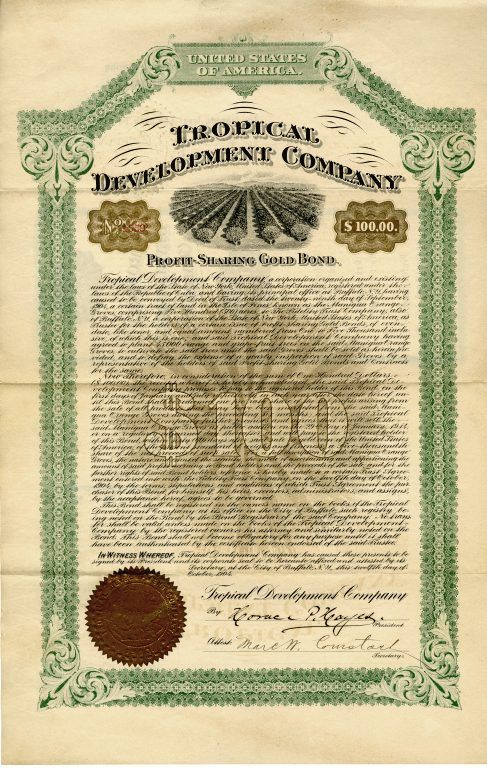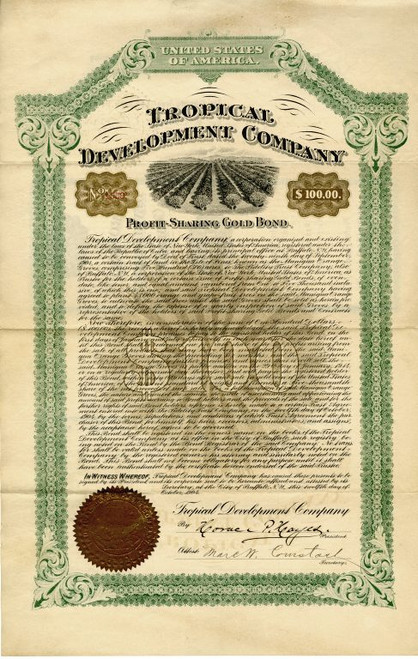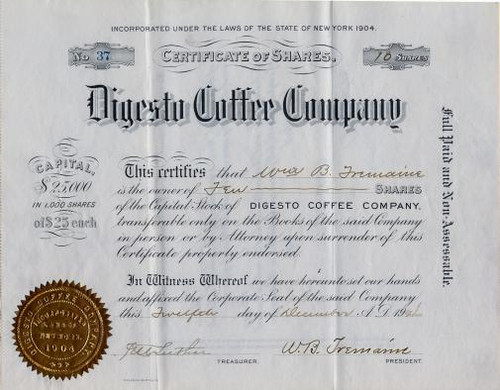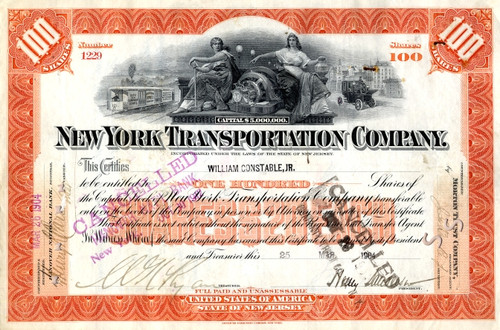Beautifull Profit Sharing Gold Bond certificate from the Tropical Development Company issued in 1904. Incorporated under the Laws of the State of New York Registered under the Laws of the Republic of Cuba. This historic document has an ornate border around it with a vignette of an orchard. This item has the signatures of the Company's President, Horace Hayes and Secretary, MarcW. Comstock. 
Certificate At the start of the twentieth century, U.S. citizens began settling and investing on the Isle of Pines off the coast of Cuba. U.S. entrepreneurs who believed the Isle was or would become U.S. territory bought vast tracts from Spanish and Cuban landowners. They then subdivided the land and marketed it to farmers and middle-class Americans still in search of opportunity on a disappearing frontier. These landholding companies' promotions helped shape the assumptions and expectations of thousands of Americans who settled on the Isle over the next few decades. Companies portrayed the Isle as a tropical paradise safe for white settlement and ripe for development. They promised high returns-on-investment for those looking to engage in citrus production for export, as well as a healthful climate for those plagued by chronic illness. Some of these settlers publicly echoed landholding companies' portrayal and remained on the Isle for years. Others found the Isle's promise to be grossly exaggerated and returned to the United States feeling swindled by unscrupulous entrepreneurs. Although set in a foreign land, U.S. interest in the Isle reveals much about life in the United States, including the changing nature of expansion, the growing power of advertising, and middle-class discontent. The Tropical Development Company was born out of the Isle of Pines Company, from which it had purchased 5,200 acres on the north end of the Isle. James A. Hill, a New York–based publisher, served as treasurer of the Isle of Pines Company as well as vice president of the Tropical Development Company. The Tropical Development Company was best known for founding the town of McKinley, named for the slain U.S. president. As described in its company literature, the Tropical Development Company designed the town to help support and sustain the American presence on the Isle. To finance this development, the company sold bonds. It was expected that these bonds would mature in ten years, specifically on gMcKinley Day,h January 29, 1914. At that point, it planned to sell its 500-acre company citrus grove in five-acre plots to the highest bidder (the company expected to fetch $1,000 per acre by then), the proceeds of which would then be divided among all bondholders.58 Although the town of McKinley endured for many years, no records indicate if the company successfully sold off its groves on gMcKinley Dayh or how long it stayed in operation. From the Prospectus INCREASE IN LAND VALUES GUARANTEED. Land Values advance by leaps and bounds wherever the natural resources of a country warrant development and where development is taking place. We Wish to call the attention of each prospective purchaser to the means which the Tropical Development Company is employing to assure immediate and exten- sive development at McKinley, and hence early and large advances in the value of every acre of its fertile land; and, furthermore, the attractive and generous method by means of which every purchaser of our profit-sharing gold development bonds participates in the enormous profits sure to come both from the culti- vation of the 500 acres of the Manigua Orange Groves and from the increase in value of the numerous smaller private groves and tracts clustering around it. EXTENSIVE IMPROVEMENT CERTAIN. The Tropical Development Company takes the lead in this development, and by the establishment of the 500 acre Manigua Groves inaugurates the thorough cultivation which will shortly make the 5,200 acres of the McKinley Tract at once the center of a great fruit and vegetable section owned by Americans, developed by Americans, and settled by Americans, and, moreover, increases the value of the adjoining properties to the usual California valuation of from $250 to $500 per acre unplanted, and from $1,000 to $1,500 per acre set in orange trees. Remember, the planting of the Manigua Orange Groves alone, which we have begun and guarantee to bring to bearing, assures at McKinley an immediate population of from 500 to 600 thrifty Americans (including the fruit growers and their families) who. will be engaged in working on the grove, besides the throngs who will flock to this center of American development. This Immense Property, one of the largest citrus groves in the world, on which the Company is spending thousands of dollars, wili prove beyond the shadow of a doubt, even to the most unobservant visitor, the great fertility of this favored section and is certain to increase many fold the value of every surrounding acre. Remember, we are actually bringing to the highest possible state of cultivation 10 per cent. (500 out of 5,200 acres — 200 acres being used for our numerous roads and drives) of the whole McKinley Tract and assuring the establishment of " a City of Orange Groves." EVERY BONDHOLDER DOUBLY A PARTNER. The Profit-sharing Gold Bonds of the Tropical Development Company which are issued on the 500 acres of the Manigua Orange Groves are in themselves a most profitable investment, allowing all purchasers to secure an interest in the Manigua Orange Groves far below the real value of this property. The Free Gift of land and city lots which go to early purchasers of these Bonds now selling at a discount permits early investors to become not only Bond holders in the Manigua Groves but also Property holders of McKinley at no additional cost and thus share not only in profits of the Manigua Orange Groves but also in the increase in land values of the surrounding lands which the establishment of this Grove will produce. This is positively the fairest real estate offer ever made and one which will, with scientific accuracy, fulfill the highest expectations of our investors. No Other Land Company makes any such offer as this ; not only to allot you land, but to assure by extensive improvements the increase in value of your property, and to make you a partner with it both in the profits from cultivation and the increase in the value of its lands. Do Not take more land than you can cultivate or pay to have cultivated. Remember, properly cultivated in any one of a dozen crops, such as oranges, coffee, cotton, winter vegetables or tobacco, these lands will yield from $500 to $1,000 per acre annually. Remember, for every ten acres we allot as a bonus we bring one acre to a high state of cultivation. Landholding company executives came from a variety of industries. The Isle of Pines Company featured publishers and shippers. Among the Tropical Development Company's directors were former Buffalo mayor Erastus Knight and bookseller Frederik A. Fernald, who sold his business to become an investor in the company.59 The Isle of Pines Investment Company was mostly a family affair. Real estate mogul Truman Swetlandstarted the company in 1908 when he bought nearly 10,000 acres at San Francisco de las Piedras, the largest undivided tract at the time, from the Sarda family for $55,000. Among the company's directors were three of Swetland's sons, who were integral to the tract's development. Frederick Swetland Jr. noted that gAfter my grandfather signed the contract, the rest of the family finally dug up the purchase money to bail him out (eafter all, how can you go wrong on land at $5 an acre'?).h60 Over the next half-century, the Swetland family engaged in a variety of business enterprises, including land sales, citrus production for export, resort development (the family converted part of its house into an inn for tourists), and cattle raising. The family soon emerged as one of the most prominent on the Isle. They retained their property in San Francisco over four generations up to the Cuban Revolution, and would be one of the last American families to leave. History Following its defeat in the SpanishAmerican War and the Cuban War of Independence, Spain dropped all claims to Cuba under the terms of the 1898 Treaty of Paris. The Platt Amendment of 1901, which defined Cuba's boundaries for the purposes of U.S. authorities, left the U.S. position on sovereignty over Isla de la Juventud undetermined. This led to competing claims to the island by the United States and Cuba. In 1907, the U.S. Supreme Court decided, in Pearcy v. Stranahan, that control of the island was a political decision, not a judicial one. In 1916, a pamphlet titled Isle of Pines: American or What? called for the U.S. to annex or purchase the island to settle the issue. In 1904, Cuba and the United States negotiated and signed the Hay-Quesada Treaty, which recognized Cuba's sovereignty over the island. The U.S. Senate ratified this agreement on March 13, 1925, over the objections of some four hundred United States citizens and companies, who owned or controlled about 95% of the island's land. Prior to 1976, the island was part of La Habana Province. With the political and administrative reorganization of Cuban provinces in 1976, the island was given the status of "special municipality". Fidel Castro presided at a ceremony changing the name of the island from Isla de Pinos to Isla de la Juventud on 3 August 1978.[This was the realization of a promise that he had made in 1967, when he said "Let's call it the Isle of Youth when the youth have done something grand with their work here, when they have revolutionized the natural environment, when they see the fruits of their labor and have revolutionized society here." History from Wikipedia and OldCompany.com (old stock certificate research service)

Certificate








